Intel's Architecture Day 2018: The Future of Core, Intel GPUs, 10nm, and Hybrid x86
by Dr. Ian Cutress on December 12, 2018 9:00 AM EST- Posted in
- CPUs
- Memory
- Intel
- GPUs
- DRAM
- Architecture
- Microarchitecture
- Xe
The Next Generation Gen11 Graphics: Playable Games and Adaptive Sync!
Some of the first words out of the mouth of Raja Koduri about graphics is that Intel has a duty to its one billion customers with integrated graphics to give them something that is useful, and that it is time for Intel to provide graphics which people can actually play games on. Given his expertise on the matter, it shouldn’t sound too far-fetched: more people play games than ever before, and these users want to play no matter what their hardware. To that end, Raja stated that Gen11 graphics is the first step in a new graphics policy to provide the performance and features to let gamers play the most popular games, no matter what implementation.
Gen11: Intel’s first GT2 TFLOPS Graphics
In 2015, Intel launched the Skylake processor with Gen9 integrated graphics. Rather than moving straight to Gen10 the next time around, we were given Gen 9.5 in both Kaby Lake and Coffee Lake, which supposedly draw features from what would have been Gen 10. Actually, the graphics for Intel’s failed 10nm Cannon Lake chip were meant to be called Gen10, however Intel never released a Cannon Lake processor with working integrated graphics, and because Gen11 goes above and beyond what Gen10 would have been, we’ve gone straight to Gen11. Make sense? Well Intel didn’t even bother to acknowledge Gen10 in its history graph:
We will see Gen11 graphics being paired with Sunny Cove cores on 10nm sometime in 2019 according to the roadmaps. However rather than give a detailed architecture layout for the new product, we instead were given a rather high level diagram.
From here we can deduce a few things. We were told that this configuration is the GT2 config, which will have 64 execution units, up from 24 in Gen9.5. These 64 EUs are split into four slices, with each slice being made of two sub-slices of 8 EUs a piece. Each sub-slice will have an instruction cache and a 3D sampler, while the bigger slice gets two media samplers, a PixelFE, and additional load/store hardware. Intel lists Gen11 targeting efficiency, performance, advanced 3D and media capabilities, and a better gaming experience.
Intel didn’t go into too much detail regarding how the EUs are at higher performance, however the company did say that the FPU interfaces inside the EU are redesigned and it still has support for fast (2x) FP16 performance as seen in Gen9.5. Each EU will support seven threads as before, which means that the entire GT2 design will essentially have 512 concurrent pipelines. In order to help feed these pipes, Intel states that it has redesigned the memory interface, as well as increasing the L3 cache of the GPU to 3 MB, a 4x increase over Gen9.5, and it is now a separate block in the unslice section of the GPU.
Other features include tile-based rendering, which Intel stated the graphics hardware will be able to enable/disable on a render pass basis. This will make Intel the final member of the PC GPU vendor community to implement this, following NVIDIA in 2014 and AMD in 2017. While not a panacea to all performance woes, a good tile rendering setup plays well to the bandwidth limitations of an integrated GPU. Meanwhile Intel's lossless memory compression has also improved, with Intel listing a best case performance boost of 10% or a geometric mean boost of 4%. The GTI interface now supports 64 bytes per clock read and write to increase throughput, which works with the better memory interface.
Coarse Pixel Shading, Intel's implementation of multi-rate shading and similar in scope to NVIDIA’s own Variable Pixel Shading, is also supported. This allows the GPU to reduce the amount of total shading work required by shading some pixels on a less than 1:1 basis. Intel showed two demos for CPS, where pixel shading was reduced either as a function of object distance from camera (so you do less work when things are further away), or reduced as a function of how close the object is to the center of the screen, designed to help features like foveated rendering for VR. With a 2x2 pixel stencil applied – meaning only one pixel shading operation was done per block of 4 pixels – Intel stated a ~30% increase in frame rates in supported games. Unfortunately this needs to be applied on a game-by-game basis in order to prevent significant image quality losses, so the performance gains won't be immediate or universal.
For the media block, Intel says that the Gen11 design includes a ground up HEVC encoder design, with high quality encode and decode support. Intel cited the fact that its media fixed function units are already used in the datacenter for video processing, and home users can take advantage of the same hardware. Intel also stated that by using parallel decoders it can either support concurrent video streams or they can be combined to support a single large stream, and this scalable design will allow future hardware to push the peak resolutions up to 8K and beyond.
The highlight of the display engine is support for Adaptive Sync technologies. We were told that it was announced back at the launch of Skylake, but now it is finally ready to go into Intel’s integrated graphics. This goes in hand with HDR support due to its high-precision data path.
One thing in this presentation that Intel didn’t mention directly is that Gen11 graphics would appear to have Type-C video output support, potentially indicating that Intel has integrated the necessary mux into the chipset itself, removing another IC from the motherboard design.


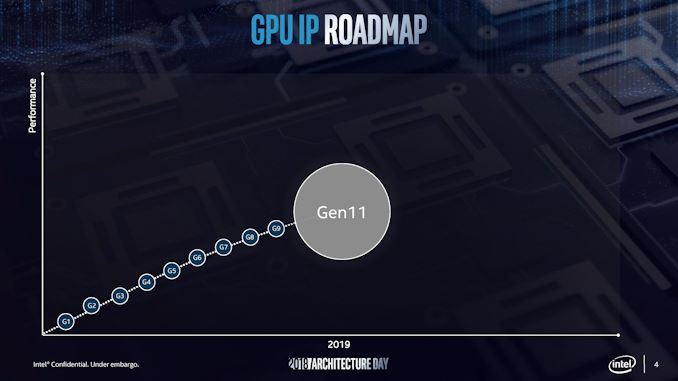
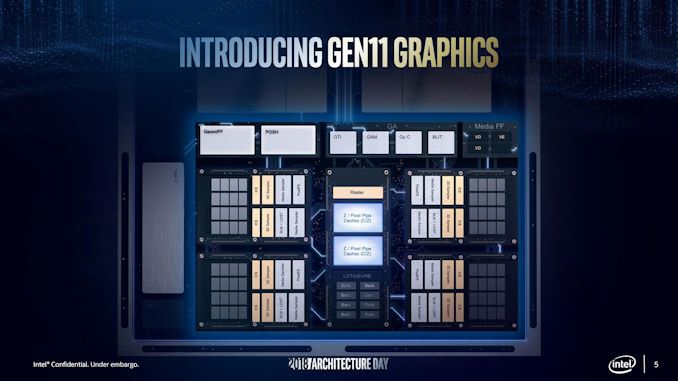
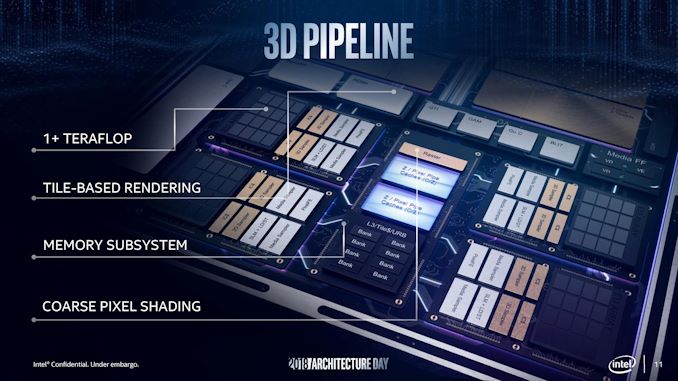
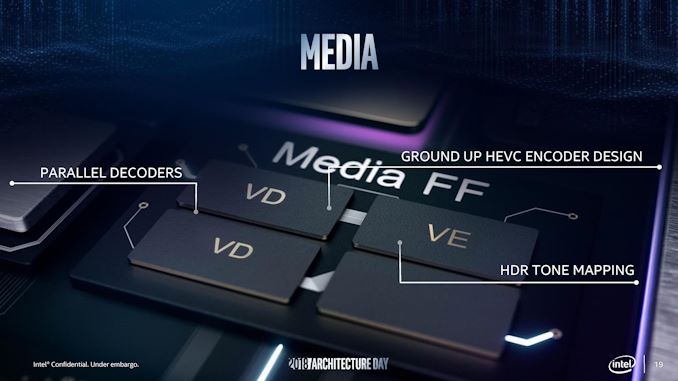
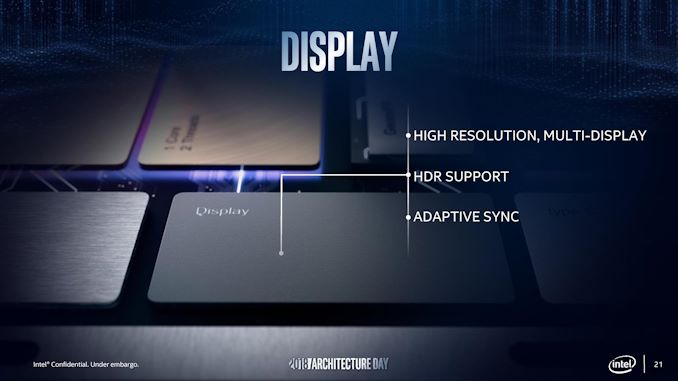
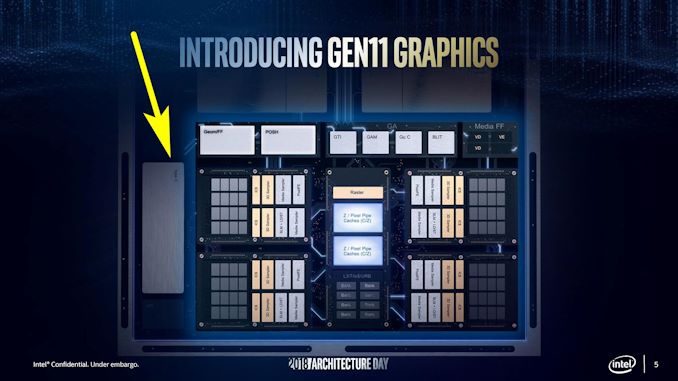








148 Comments
View All Comments
prisonerX - Wednesday, December 12, 2018 - link
And you're a special brand of pathetic. Congrats.Don't worry though, one day you'll hit puberty and things will improve.
LogitechFan - Wednesday, December 12, 2018 - link
Oh yes, amdturds are THE breed of stupid to behold...drunkenmaster - Wednesday, December 12, 2018 - link
Would that be Marvell's chip from 3 years ago that suddenly people are talking about... which is just a chip on an interposer with an HBM chip. HBM which AMD co-developed, had prototype APU packages using it in 2011 and launched Fury X with HBM on an interposer 3 years ago.Right, but AMD didn't pioneer it, because Marvell made a dramatically less complex switch using the same concept at the same time AMD did, but you know, AMD co-developed the memory, they worked with the packaging plants for years to be able to mass produce interposer packaged products and Fury X was the reason HBM went into full production in the first place.... but sure, AMD definitely didn't pioneer this latest move.
ajc9988 - Wednesday, December 12, 2018 - link
http://www.eecg.toronto.edu/~enright/micro14-inter... http://www.eecg.toronto.edu/~enright/Kannan_MICRO4... https://youtu.be/G3kGSbWFig4 https://seal.ece.ucsb.edu/sites/seal.ece.ucsb.edu/... https://www.youtube.com/watch?v=d3RVwLa3EmM&t=...qap - Wednesday, December 12, 2018 - link
Well ... yeah. Intel had multi-chip CPUs almost 15 years ago (look for Pentium D). And it was mocked by AMD and its fans.I thought that the mocking intel did last month was just to remind AMD, what they said then and I found it hilarious. But maybe not. People don't change and it's completely plausible, that it was said by someone, who does't know the history.
Topweasel - Wednesday, December 12, 2018 - link
Never Mocked by AMD. They just made sure to point out that their 2 cores with the X2 and quad with the Phenom where "real" multicore chips. It mattered more back then because Intel's boards had FSB's instead of direct connections and the separate chips had to talk through the FSB and chipset northbridge to talk to each other. Also AMD hadn't been rambling on thier glue tech for years (with no product yet on market using it (Kaby-G isn't actual EMIB)) when they made their statements.AMD promoted their products said they are better because they were real. There is a negative connotation with that. But that is different then calling out your competitor for using "glue".
29a - Wednesday, December 12, 2018 - link
"Well ... yeah. Intel had multi-chip CPUs almost 15 years ago (look for Pentium D). And it was mocked by AMD and its fans."I think pretty much everyone mocked anything P4 related, you have to admit it was pretty bad.
FreckledTrout - Wednesday, December 12, 2018 - link
What's P4? To flush it down the toilet.tshoobs - Wednesday, December 12, 2018 - link
Never heard that one before! So true, the P4 was such an embarrassment.JlHADJOE - Wednesday, December 12, 2018 - link
lol this takes me right back to the days of the P4, and the awesome "x is good... for me to POOP on!" meme